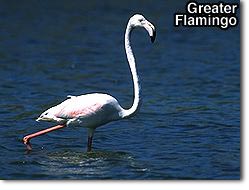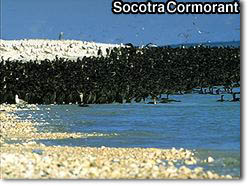Birds found on UAE's Coasts and Mudflats
 The Arabian Gulf and its shallow saline lagoons and extensive mudflats serve as important winter feeding grounds for millions of Arctic and central Asian migrant shorebirds. One hundred and twenty six thousand wetland birds were counted in January during the 1995 Asian Waterfowl Census, including 41,000 wildfowl, 42,000 waders, 38,000 gulls and 4,200 terns, so it is worthwhile spending some time watching the coasts and lagoons. The sheltered tidal lagoon at Khor Dubai can hold about 12,000 birds at any one time during the winter season, including hundreds of the much sought-after species broad-billed sandpiper and lesser sand plover. This site has been declared a Wildlife Sanctuary by Dubai's Crown Prince, General Sheikh Mohammed bin Rashid Al Maktoum, whose interest in the high numbers of greater flamingos Phoenicopterus ruber occurring throughout the year encouraged him to build a breeding island in the centre of the lagoon. Other species of interest here are spotted eagle Aquila clanga (late October to March only), greater sand plover and Pacific golden plover Pluvialis fulva (September to April). The Arabian Gulf and its shallow saline lagoons and extensive mudflats serve as important winter feeding grounds for millions of Arctic and central Asian migrant shorebirds. One hundred and twenty six thousand wetland birds were counted in January during the 1995 Asian Waterfowl Census, including 41,000 wildfowl, 42,000 waders, 38,000 gulls and 4,200 terns, so it is worthwhile spending some time watching the coasts and lagoons. The sheltered tidal lagoon at Khor Dubai can hold about 12,000 birds at any one time during the winter season, including hundreds of the much sought-after species broad-billed sandpiper and lesser sand plover. This site has been declared a Wildlife Sanctuary by Dubai's Crown Prince, General Sheikh Mohammed bin Rashid Al Maktoum, whose interest in the high numbers of greater flamingos Phoenicopterus ruber occurring throughout the year encouraged him to build a breeding island in the centre of the lagoon. Other species of interest here are spotted eagle Aquila clanga (late October to March only), greater sand plover and Pacific golden plover Pluvialis fulva (September to April).
 Khor al Beidah, at Umm al Quwain is the most accessible site to see crab plover in winter, when over 300 birds are present at their high tide roost. Great knot is regular here too. One of the world's largest colonies of Socotra cormorants nests nearby in late autumn and there are often flocks of several thousand flying offshore, visible from the coastline. About 100 kms north-east of Dubai is Al Jazeerah Khor, another network of lagoons. It is a good place to see terek sandpiper Xenus cinereus , while flocks of slender-billed gull Larus genei and Saunders' little tern Sterna saundersi in winter, best viewed from the high dunes which guard the bay. These scrub-covered dunes usually host several species of Sylvia warbler in winter and spring, including desert, orphean S.orpheus and Ménétries' warbler S.mystacea and 'Siberian' lesser whitethroat Sylvia curruca (blythi) . Khor al Beidah, at Umm al Quwain is the most accessible site to see crab plover in winter, when over 300 birds are present at their high tide roost. Great knot is regular here too. One of the world's largest colonies of Socotra cormorants nests nearby in late autumn and there are often flocks of several thousand flying offshore, visible from the coastline. About 100 kms north-east of Dubai is Al Jazeerah Khor, another network of lagoons. It is a good place to see terek sandpiper Xenus cinereus , while flocks of slender-billed gull Larus genei and Saunders' little tern Sterna saundersi in winter, best viewed from the high dunes which guard the bay. These scrub-covered dunes usually host several species of Sylvia warbler in winter and spring, including desert, orphean S.orpheus and Ménétries' warbler S.mystacea and 'Siberian' lesser whitethroat Sylvia curruca (blythi) .
Khor Kalba, about 12 kms south of Fujairah town, facing the Gulf of Oman, is by far the most interesting site on the country's east coast. Its unique stands of black mangrove Avicennia marina , are home of the white-collared kingfisher, generally rare and localised in Arabia and here belonging to the distinctive race kalbaensis , named after the site which shelters it. Socotra cormorant, sooty gull, bridled tern, swift tern Sterna bergii, lesser crested tern, white-cheeked tern, pomarine skua Stercorarius pomarinus and Arctic skua Stercorarius parasiticus are seasonally common. Less common, Audubon's (Persian) shearwater Puffinus lherminieri (persicus ) and Wilson's storm-petrel Oceanites oceanites are sometimes visible from the shoreline.
|